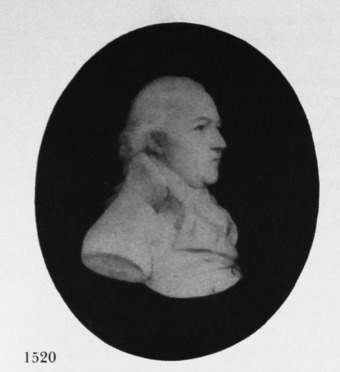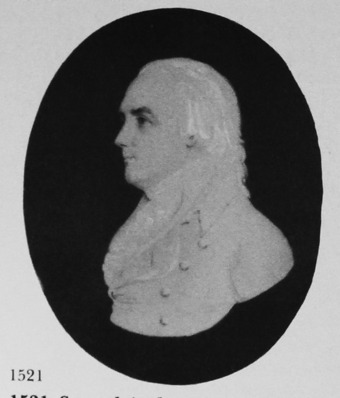Andrews, Samuel (McKechnie Section 6)
A painter of miniatures on ivory and of profiles en grisaille, recorded by Jackson (Dictionary), Long, Foskett and Graham Reynolds (English Portrait Miniatures, London, 1952).
An Irishman by birth, Andrews appears to have started his career in England (two silhouettes en grisaille, in my collection, were taken in Bath c. 1790).In 1791 he travelled to India, where he set up as a miniaturist in Madras; he became a close follower of the great miniaturist John Smart, who was also working in this city. After Smart left India in 1795 to return to England, Andrews took his house. Foskett suggests that he was the Samuel Andrews who in July 1795 married one Janetta Christina Elbracht. In 1798 Andrews moved to Calcutta, where he painted some of the works (both miniatures and pieces en grisaille) referred to below. Andrews died in Patna on 21 September 1807.
The two illustrated profiles (which were sold by Sotheby and Company, London, on 15 March 1971) seem to indicate that Andrews worked in England before setting off for India, for the sitters' costume suggests that they were painted before 1791. They are unsigned, but each bears an inscription ('by S. Andrews of Calcutta and Bath') which gives substance to the theory that Andrews did indeed work for a time in Bath. The theory is further supported by the fact that the two sitters of these profiles (a Mr John Roberts and his son) were residents of Bath.
Most recorded examples of Andrews's work, however, date from his period in India. They include one en grisaille sold by Sotheby and Company, London, from the Coke collection in July 1931. Jackson records a piece (probably en grisaille also) showing two busts in one frame. Long records two en grisaille examples, each 3¾ x 3 in. and signed 'S. Andrews' followed (in one case) by the words 'Calcutta, July, 1803' and (in the other) by '1807'. Another signed example, presumably en grisaille, recorded by Jackson and owned at the time by Commander Melville A. Jamieson, was also painted in Calcutta in July 1803. Foskett illustrates two miniatures and also two profiles painted en grisaille. One of these miniatures (of a military subject, signed and dated 1796) is in the Victoria and Albert Museum, London.
Recent research has led Mr Graham Reynolds to consider that certain miniatures signed 'S. A.', of hitherto doubtful provenance, are the work of Samuel Andrews.
Although Andrews's known en grisaille pieces are all similar in size, the style of painting varies a little. The colour of the backgrounds is a dark brownish-grey, achieved by the use of body colour. Umber appears to have been used on the portrait of the elder John Roberts (applied with much delicacy), sepia on the portrait of his son. This difference in the choice of colour accounts for the difference in the depth of the work around the eyes on the two profiles. Both portraits show touches of Chinese white to provide highlights, and on the cheek of the younger John Roberts there is a hint of flesh tint. The height of the collar on the profile of the elder John Roberts is emphasised by much shading between lapel and collar; this shading is not present on the other profile. An en grisaille example illustrated by Foskett is painted in the same style as the portrait of the younger John Roberts.
A 'back-line', varying in depth, is visible on the arm at the truncation on most examples of Andrews's work (it is absent from the profile of the younger John Roberts).
In one en grisaille profile (illustrated by Foskett) the sitter, a woman, is posed so that both her shoulders are seen, with her face turned to profile in dexter. Her hair appears to have been painted entirely in umber brush-work and her face shows flesh tints.
The ovals on which these en grisaille examples are painted are all larger than those apparently used, for instance, by de Janvry, measuring about 33¾ x 3 in. Most of the frames are of papier mâché, but some examples in horn frames (of similar design) have been seen, and one illustrated piece is framed in mahogany. Leo R. Schidlof (The Miniature in Europe, 4 vols, Austria, 1964) notes that Andrews's miniatures are painted with a very pointed brush; he also remarks on the greenish shadows on the sitters' faces, and on the vivid flesh tints. As he dates these examples to 1780-90, they may have been painted in England.
No trade labels are known, although Jackson records a signature ('Andrews') on a 'ticket'. Recorded signatures are either 'S. Andrews' or 'S.A.', usually followed by the date and sometimes by the location.
Ills. 1520, 1521

John Roberts the leder, of Bath
Profile painted on ivory en grisaille
c. 1790
3 ¾ x 3 in./96 x 77mm.
Frame: mahogany, in design similar to standard papier mâché frame
An inscription on the reverse (abbreviated here) reads, ‘John Roberts, Esq,…of Bath…. The son of the Rector of Sonning who was also of Bath.’
Author’s collection

John Roberts the younger, of Bath
Profile painted on ivory en grisaille
c. 1790
3 5/8 x 3in./93 x 77mm.
Frame: papier mâché
An inscription on the reverse states that the sitter is the son of the subject of 1520.
Author’s collection
